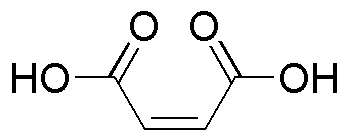Maleic acid is widely utilized in research focused on:
- Polymer Production: It's a key ingredient in the synthesis of various polymers, including polyesters and alkyd resins, which are used in coatings, adhesives, and plastics.
- Agricultural Chemicals: Maleic acid is employed in the formulation of herbicides and pesticides, enhancing their effectiveness and stability, which is crucial for crop protection.
- Pharmaceuticals: It serves as an intermediate in the production of certain medications, contributing to the development of effective therapeutic agents.
- Food Industry: Used as a food additive, it acts as a flavor enhancer and acidity regulator, improving the taste and shelf life of various food products.
- Cosmetics: Maleic acid is incorporated in personal care products for its ability to adjust pH levels and improve the texture of creams and lotions.
General Information
Properties
Safety and Regulations
Applications
Maleic acid is widely utilized in research focused on:
- Polymer Production: It's a key ingredient in the synthesis of various polymers, including polyesters and alkyd resins, which are used in coatings, adhesives, and plastics.
- Agricultural Chemicals: Maleic acid is employed in the formulation of herbicides and pesticides, enhancing their effectiveness and stability, which is crucial for crop protection.
- Pharmaceuticals: It serves as an intermediate in the production of certain medications, contributing to the development of effective therapeutic agents.
- Food Industry: Used as a food additive, it acts as a flavor enhancer and acidity regulator, improving the taste and shelf life of various food products.
- Cosmetics: Maleic acid is incorporated in personal care products for its ability to adjust pH levels and improve the texture of creams and lotions.
Documents
Safety Data Sheets (SDS)
The SDS provides comprehensive safety information on handling, storage, and disposal of the product.
Product Specification (PS)
The PS provides a comprehensive breakdown of the product’s properties, including chemical composition, physical state, purity, and storage requirements. It also details acceptable quality ranges and the product's intended applications.
Certificates of Analysis (COA)
Search for Certificates of Analysis (COA) by entering the products Lot Number. Lot and Batch Numbers can be found on a product’s label following the words ‘Lot’ or ‘Batch’.
*Catalog Number
*Lot Number
Certificates Of Origin (COO)
This COO confirms the country where the product was manufactured, and also details the materials and components used in it and whether it is derived from natural, synthetic, or other specific sources. This certificate may be required for customs, trade, and regulatory compliance.
*Catalog Number
*Lot Number
Safety Data Sheets (SDS)
The SDS provides comprehensive safety information on handling, storage, and disposal of the product.
DownloadProduct Specification (PS)
The PS provides a comprehensive breakdown of the product’s properties, including chemical composition, physical state, purity, and storage requirements. It also details acceptable quality ranges and the product's intended applications.
DownloadCertificates of Analysis (COA)
Search for Certificates of Analysis (COA) by entering the products Lot Number. Lot and Batch Numbers can be found on a product’s label following the words ‘Lot’ or ‘Batch’.
*Catalog Number
*Lot Number
Certificates Of Origin (COO)
This COO confirms the country where the product was manufactured, and also details the materials and components used in it and whether it is derived from natural, synthetic, or other specific sources. This certificate may be required for customs, trade, and regulatory compliance.

